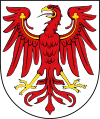From Wikipedia, the free encyclopedia
 Coat of arms of Brandenburg Coat of arms of Brandenburg
|
|
Brandenburg (German: [ˈbʁandn̩bʊʁk] ⓘ), officially the State of Brandenburg (see Names), is a state in northeastern Germany. Brandenburg borders Poland and the states of Berlin, Mecklenburg-Vorpommern, Lower Saxony, Saxony-Anhalt, and Saxony. It is the fifth-largest German state by area and the tenth-most populous, with 2.5 million residents. Potsdam is the state capital and largest city, and other major towns are Cottbus, Brandenburg an der Havel and Frankfurt (Oder).
Brandenburg surrounds the national capital and city-state of Berlin, and together they form the Berlin/Brandenburg Metropolitan Region, the third-largest metropolitan area in Germany. There was an unsuccessful attempt to unify both states in 1996 and the states still cooperate on many matters.
Brandenburg originated in the Northern March in the 900s AD, from areas conquered from the Wends. It later became the Margraviate of Brandenburg, a major principality of the Holy Roman Empire. In the 15th century, it came under the rule of the House of Hohenzollern, which later established Brandenburg-Prussia, the core of the later Kingdom of Prussia. From 1815 to 1947, Brandenburg was a province of Prussia.
Following the abolition of Prussia after World War II, Brandenburg was established as a state by the Soviet Military Administration in Germany, and became a state of the German Democratic Republic in 1949. In 1952, the state was dissolved and broken up into multiple regional districts. Following German reunification, Brandenburg was re-established in 1990 and became one of the five new states of the Federal Republic of Germany.
Southeastern Brandenburg contains part of the historical Lower Lusatia, and most of these localities have two official languages, German and Lower Sorbian (of the Sorbs/Wends). (Full article...)
Read more...
|
|

